What would my neighbors be like in Chapala and Ajijic, Mexico?
Santiago Hernandez - Chapala Med
 Most of the locals in Chapala are blue-collar workers. There are lots of army and military veterans in Chapala as well. Expats tend to relocate to Chapala because the cost of living is cheaper there. What makes Chapala very beautiful is the lake itself, and the malecon, which is the boardwalk along the lake.
Most of the locals in Chapala are blue-collar workers. There are lots of army and military veterans in Chapala as well. Expats tend to relocate to Chapala because the cost of living is cheaper there. What makes Chapala very beautiful is the lake itself, and the malecon, which is the boardwalk along the lake.Ajijic, which is a town on Lake Chapala, is more artistic and very picturesque than the town of Chapals. A lot of it has to do with the nature of the people who come to...
 Most of the locals in Chapala are blue-collar workers. There are lots of army and military veterans in Chapala as well. Expats tend to relocate to Chapala because the cost of living is cheaper there. What makes Chapala very beautiful is the lake itself, and the malecon, which is the boardwalk along the lake.
Most of the locals in Chapala are blue-collar workers. There are lots of army and military veterans in Chapala as well. Expats tend to relocate to Chapala because the cost of living is cheaper there. What makes Chapala very beautiful is the lake itself, and the malecon, which is the boardwalk along the lake.Ajijic, which is a town on Lake Chapala, is more artistic and very picturesque than the town of Chapals. A lot of it has to do with the nature of the people who come to live there. There are lots of people in Ajijic who are semi-retired, who are writers, sculptors, etc. They help by focusing on the beautification and maintenance of the magical and artistic vibe of Ajijic.
So overall, your neighbors in Ajijic would mostly be people who have retired from white-collar jobs while your neighbors in Chapala would be people who are in the service industries and those who have retired from blue-collar jobs. The locals are basically the same in both Chapala and Ajijic.
There are some pockets of local people who live on the poverty line in both Chapala and Ajijic, which consequently creates a good opportunity for expats to be philanthropic. I see that a lot of the expats that relocate here become involved in certain types of community service or being philanthropic in any way, shape, or form.
On a personal level, I belong to the Rotary Club of Ajijic and we do a lot of philanthropic events and a lot of community service projects. As much as 60% of the expats here participate in these charitable events.
The difference in wealth is very evident here. About half a mile behind my office building up to the hills, there is poor community called the Tepehua community. I often donate my time to do clinic duty at the community center. The comparison is almost like night and day between that hill and the building where I have my office. The building where my office is located is very modern and very spacious. We have a koi pond and it’s very peaceful.
It is mainly expats who started the community service projects at the Tepehua community and we just carried on from there. I have seen other expats who may not opt to help people but they tend to rescue dogs. There is a large dog rescue organization here. They are frequently out spaying and neutering cats and dogs. There are definitely a lot of opportunities for people to get involved to leave this world better than how we found it.
(Pictured: Tennessee Williams lived and played poker every night in in Ajijic , Mexico, while writing the short story that eventually was expanded into the play, A Streetcar Named Desire.)
Posted January 20, 2016
Michael Kavanaugh - Continental Realty
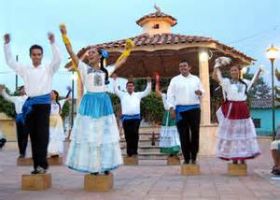 In Chapala your neighbors are going to be mostly Mexican nationals. In Ajijic they’ll probably be a mix of Americans and Canadians and Mexican nationals. Depending on the neighborhood, your neighbors might be all Americans or Canadians. It varies.
In Chapala your neighbors are going to be mostly Mexican nationals. In Ajijic they’ll probably be a mix of Americans and Canadians and Mexican nationals. Depending on the neighborhood, your neighbors might be all Americans or Canadians. It varies. If you’re in the village of Ajijic, you could have a very expensive house owned by a Mexican from Guadalajara or an American who rents it out or who lives there fulltime next to a...
 In Chapala your neighbors are going to be mostly Mexican nationals. In Ajijic they’ll probably be a mix of Americans and Canadians and Mexican nationals. Depending on the neighborhood, your neighbors might be all Americans or Canadians. It varies.
In Chapala your neighbors are going to be mostly Mexican nationals. In Ajijic they’ll probably be a mix of Americans and Canadians and Mexican nationals. Depending on the neighborhood, your neighbors might be all Americans or Canadians. It varies. If you’re in the village of Ajijic, you could have a very expensive house owned by a Mexican from Guadalajara or an American who rents it out or who lives there fulltime next to a Mexican’s small and inexpensive home in which two families may be living.
Where I live, in San Antonio, my neighbors are a mix of Americans, Canadians, and some wealthier Mexicans. For the Mexicans, the house may be a weekend house. Some of them are seldom used but they have a maid and a gardener, they’re kept up, and they owner may come once a month or once in every two months.
There are neighborhoods surrounding the center of Ajijic like La Floresta and Villa Nova that are planned communities that are 20 to 40 years old. In these communities there is a mix of Mexicans, Canadians, and Americans. These are more homogenous type area where almost everyone is upper middle class, whereas, in Ajijic, it’s a mix. For example, you could very well live next door to your maid.
(Ballet Folklorico dancers, Chapala, Mexico, pictured.)
Posted August 22, 2016
Percy Pinklebutt - Percy Pinklebutt Enteprises
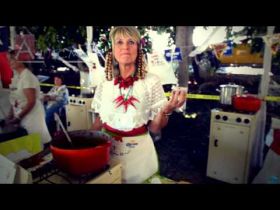 There is a very large expat community and my understanding is that it is one of the biggest American expat communities in the world. There are also people from many other countries worldwide and you could have any of them living next to you. Also you are also likely to have your neighbor who is a local businessman or from Guadalajara who is only there on the weekends with his family. You also might be lucky enough to have neighbors who have always lived at the lake and then you will...
There is a very large expat community and my understanding is that it is one of the biggest American expat communities in the world. There are also people from many other countries worldwide and you could have any of them living next to you. Also you are also likely to have your neighbor who is a local businessman or from Guadalajara who is only there on the weekends with his family. You also might be lucky enough to have neighbors who have always lived at the lake and then you will... There is a very large expat community and my understanding is that it is one of the biggest American expat communities in the world. There are also people from many other countries worldwide and you could have any of them living next to you. Also you are also likely to have your neighbor who is a local businessman or from Guadalajara who is only there on the weekends with his family. You also might be lucky enough to have neighbors who have always lived at the lake and then you will have a great source of local information right next door.
There is a very large expat community and my understanding is that it is one of the biggest American expat communities in the world. There are also people from many other countries worldwide and you could have any of them living next to you. Also you are also likely to have your neighbor who is a local businessman or from Guadalajara who is only there on the weekends with his family. You also might be lucky enough to have neighbors who have always lived at the lake and then you will have a great source of local information right next door. There are four towns here and each one has it’s own ambience. Ajijic is considered the most popular for many expats and it may be likely that you have more chance in Ajijic of having neighbors who are expats like you will be.
I went recently to a dinner party that had a German, a Brit, a French-Canadian, a Mexican, and a handful of Americans all at the table and I am Scottish. I also love to stop in town and eat tacos and meet some Mexican friends on the lakeside for sunsets and a carne asada. You can choose to live your life either way here. You can ensconce yourself amongst the expat community if that’s who you want to do. You an easily survive here without speaking any Spanish and all you really want is a vacation home where you still have all the comfort of similar people. If you want to spend your time with more Mexican people and other cultures, then you can do that, too. You could really make this lovely part of the world whatever you want it to be.
(Chili cookoff in Ajijic, Mexico, pictured.)
Posted September 14, 2016
Lee Steele
In the Lake Chapala area (especially Ajijic) there are several "gated communities", mostly populated by Gringos. Personally, if I had wanted to live in a Gringo gated community, I would have just stayed in the States. We prefer to live "among the locals". .jpeg)
.jpeg)
Here in Mexico, your neighbors are the best crime-prevention method. The local Mexicans look out for each other (and you).
In the Lake Chapala area (especially Ajijic) there are several "gated communities", mostly populated by Gringos. Personally, if I had wanted to live in a Gringo gated community, I would have just stayed in the States. We prefer to live "among the locals". .jpeg)
.jpeg)
Here in Mexico, your neighbors are the best crime-prevention method. The local Mexicans look out for each other (and you).
Posted September 23, 2016
Alicia Gomez - Collins Real Estate
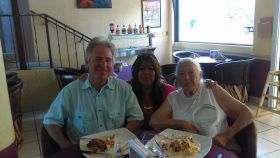 If your neighbor in Chapala and Ajijic is an American, I am pretty sure they will be good because they will buy a property in a good area with a good environment. I was in the notary public for years so I know a lot of people. In the 8 years that I was there, I’ve met a lot of people and all kinds of people. Most of the expats in Chapala and Ajijic are very nice. If you get a house in a nice area, like in La Floresta or in Chula Vista Norte, (the two more expensive communities...
If your neighbor in Chapala and Ajijic is an American, I am pretty sure they will be good because they will buy a property in a good area with a good environment. I was in the notary public for years so I know a lot of people. In the 8 years that I was there, I’ve met a lot of people and all kinds of people. Most of the expats in Chapala and Ajijic are very nice. If you get a house in a nice area, like in La Floresta or in Chula Vista Norte, (the two more expensive communities... If your neighbor in Chapala and Ajijic is an American, I am pretty sure they will be good because they will buy a property in a good area with a good environment. I was in the notary public for years so I know a lot of people. In the 8 years that I was there, I’ve met a lot of people and all kinds of people. Most of the expats in Chapala and Ajijic are very nice. If you get a house in a nice area, like in La Floresta or in Chula Vista Norte, (the two more expensive communities by Mexican standards) or in any good area in Chapala and Ajijic, your neighbors will be the same educated, polite, nice, kind, and friendly people. They will give you a welcome smile all the time, which is really good.
If your neighbor in Chapala and Ajijic is an American, I am pretty sure they will be good because they will buy a property in a good area with a good environment. I was in the notary public for years so I know a lot of people. In the 8 years that I was there, I’ve met a lot of people and all kinds of people. Most of the expats in Chapala and Ajijic are very nice. If you get a house in a nice area, like in La Floresta or in Chula Vista Norte, (the two more expensive communities by Mexican standards) or in any good area in Chapala and Ajijic, your neighbors will be the same educated, polite, nice, kind, and friendly people. They will give you a welcome smile all the time, which is really good. The Mexicans most of the time, like in my case, are rather glad to have expats in the area because expats help us a lot. They give employment to locals by hiring maids and gardeners, and we get a better quality of life because of that.
Most expats have families but sometimes these families forget that they have parents and then the maids take care of them like they were family. In the end they develop this bond and they treat each other like family. That is for most of the Mexicans but again, there are all kinds of people everywhere so there are people that would take advantage. However, that is why we are here. We look out for each other. If I see someone who is not treating an expat well just because the expat doesn’t know the laws, I tell the expat what to do or tell them to call me if they experience the same thing again. For example, if a police stops you and says he’ll take your car if you don’t give him 2,000 pesos ($110), don’t give them any money because they cannot take your car. They don’t have the authority to do that. Take a picture of them, ask for their name, and don’t give him anything. Ask for a ticket instead. If you give them money, they’re going to keep asking. So don’t let them scare you. If they say, “I’m going to take your car.” Say, “Okay, there you go. Take it.” He won’t do it because he can’t. I have seen these kinds of people and they make me feel embarrassed because I am Mexican. This is our country and the expats are our guests who are here to help and they help a lot. So in my opinion, the most that we could do for the expats here is to make them feel welcome and make them feel that they are not alone.
(Alicia Gomez with clients after closing on a house, Ajijic, Mexico, pictured.)
Posted October 2, 2016
Magy Carmona - Magy Carmona at Lake Chapala Realty
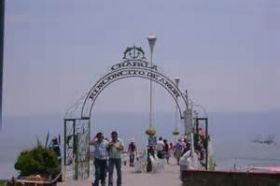 In Chapala and in Ajijic, the neighbors you’ll have will depend on the area and the street where you choose to live. You can find neighborhoods with only foreigners, or nice Mexicans mixing with foreigners, or only Mexicans. It’s a mixture of communities. Foreign communities are not limited to Americans and Canadians- there’s also a British community, a French community, and a German community. Chapala and Ajijic are very rich in different cultures.
In Chapala and in Ajijic, the neighbors you’ll have will depend on the area and the street where you choose to live. You can find neighborhoods with only foreigners, or nice Mexicans mixing with foreigners, or only Mexicans. It’s a mixture of communities. Foreign communities are not limited to Americans and Canadians- there’s also a British community, a French community, and a German community. Chapala and Ajijic are very rich in different cultures. ...
 In Chapala and in Ajijic, the neighbors you’ll have will depend on the area and the street where you choose to live. You can find neighborhoods with only foreigners, or nice Mexicans mixing with foreigners, or only Mexicans. It’s a mixture of communities. Foreign communities are not limited to Americans and Canadians- there’s also a British community, a French community, and a German community. Chapala and Ajijic are very rich in different cultures.
In Chapala and in Ajijic, the neighbors you’ll have will depend on the area and the street where you choose to live. You can find neighborhoods with only foreigners, or nice Mexicans mixing with foreigners, or only Mexicans. It’s a mixture of communities. Foreign communities are not limited to Americans and Canadians- there’s also a British community, a French community, and a German community. Chapala and Ajijic are very rich in different cultures. Chula Vista is more like a foreigners’ place. My neighbors are nice people who have been living there for many years. Most of them are homeowners, and they’re people who like to do something for the community. My neighbors are my best friends. In the street where I live, there are only four houses, and my neighbors are all Mexicans. Chula Vista’s population consists of 70% foreigners, and 30% upper and middle class Mexicans.
Rich Mexicans live in La Salvias, which is located in upper Ajijic, or in different kinds of fraccionamientos (housing developments). The very rich people do not live in Chapala, or if they do, they live in specific houses that don’t grant anyone access to. I know there are houses that are worth US $1 million or more, but the average people are just nice people- high class, but not super rich.
(Lake Chapala, Mexico, pictured.)
Posted December 12, 2016
Mark Eager - Eager & Asociados
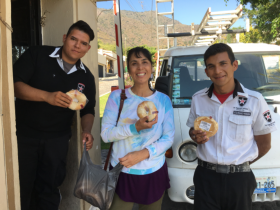 The type of neighbors you will have in Chapala and Ajijic depends where you live. If you want to live in a gated community, you’ll have a lot of Gringo neighbors. If you want to live in a community in Jocotepec, you will have a lot of Mexican neighbors right on the street who would take better care of you and pay more attention to you than your fellow Gringo neighbors in the gated community.
The type of neighbors you will have in Chapala and Ajijic depends where you live. If you want to live in a gated community, you’ll have a lot of Gringo neighbors. If you want to live in a community in Jocotepec, you will have a lot of Mexican neighbors right on the street who would take better care of you and pay more attention to you than your fellow Gringo neighbors in the gated community. Some people are really worried about security here in...
 The type of neighbors you will have in Chapala and Ajijic depends where you live. If you want to live in a gated community, you’ll have a lot of Gringo neighbors. If you want to live in a community in Jocotepec, you will have a lot of Mexican neighbors right on the street who would take better care of you and pay more attention to you than your fellow Gringo neighbors in the gated community.
The type of neighbors you will have in Chapala and Ajijic depends where you live. If you want to live in a gated community, you’ll have a lot of Gringo neighbors. If you want to live in a community in Jocotepec, you will have a lot of Mexican neighbors right on the street who would take better care of you and pay more attention to you than your fellow Gringo neighbors in the gated community. Some people are really worried about security here in Mexico. Looking out a typical window you might see a chain link fence, curled barbed wire, metal posts, and more barbed wire. Generally speaking, across Mexico, Mexicans don’t trust other Mexicans. Security is important, but the chances of a North American coming to Mexico and getting ripped off or broken into, are very few in far between.
In the neighborhood you live in, you make the best to fit in with that neighborhood, and that would be a correct answer to finding the best place for you to be.
(Jet Metier of Best Places in the World to Retire giving seasonal pastry to the neighborhood security guards, Lake Chapala, Mexico, pictured.)
Posted May 10, 2017
Chuck Bolotin - Best Mexico Movers
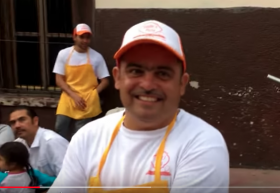 What your neighbors would be like in the Lake Chapala / Ajijic area would of course, depend on where you live. Over all Lakeside (the area from Jocotepec to Chapala, including Ajijic), probably about 80% of the people or so are Mexicans, while only 20% or so are expats.
What your neighbors would be like in the Lake Chapala / Ajijic area would of course, depend on where you live. Over all Lakeside (the area from Jocotepec to Chapala, including Ajijic), probably about 80% of the people or so are Mexicans, while only 20% or so are expats.If you choose to, you could live amongst working-class Mexicans whose occupations range from housekeepers to gardeners to proprietors of small grocery stores and shops or even the guy making pizzas outside in...
 What your neighbors would be like in the Lake Chapala / Ajijic area would of course, depend on where you live. Over all Lakeside (the area from Jocotepec to Chapala, including Ajijic), probably about 80% of the people or so are Mexicans, while only 20% or so are expats.
What your neighbors would be like in the Lake Chapala / Ajijic area would of course, depend on where you live. Over all Lakeside (the area from Jocotepec to Chapala, including Ajijic), probably about 80% of the people or so are Mexicans, while only 20% or so are expats.If you choose to, you could live amongst working-class Mexicans whose occupations range from housekeepers to gardeners to proprietors of small grocery stores and shops or even the guy making pizzas outside in Jocotepec, who is pictured above. If you did this, you would have very few neighbors who weren’t part of the group I just described, and as an expat, you would stand out.
You could also live in an area that looks like it could be part of the first group, but has been gentrified to a certain extent in certain areas, for example, the central village of Ajijic area and its surroundings. The houses in this area would tend to be traditional, with some a bit larger and some re-furbished, with a sprinkling of new homes. The lots would tend to be small. Some of the houses are quite spectacular on the inside and some have extensive and beautiful gardens. The homes could be quite expensive, for example, $400,000 for a three-bedroom house with a small garden. The people living in these areas would be quite mixed, from the same housekeepers who lived in the first group who live in a home that may have been in their family for generations, to the upper-middle class American who cashed out of their home in Northern California. As time goes on, the former are selling and the latter are buying.
Another place you could choose to live would be in one of the many fraccionamientos (residential developments ranging in size from less than a dozen houses to several hundred), some of which have their own golf course, pool, tennis, etc. Some fraccionamientos are brand new and others have been around for many decades. Most but not all have some type of security such as a live guard or some type of security gate. In these areas, it is not unusual to have a mix of perhaps 1/3 local Mexicans, 1/3 expats and 1/3 wealthier Mexicans (usually from Guadalajara) who visit only on the weekends, if then. Given that the part-time wealthy Mexicans are so rarely at their second or third home at the lake, the feel is that the area is about evenly split between Mexicans and expats.
Interested in moving to Mexico? Check out Best Mexico Movers.
Posted August 10, 2018



.png)